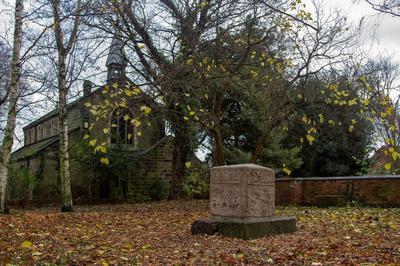The Birley Bush Steen, The Kemnay Steens
By
James Winnett
2020
- Sculpture
- Participatory & Collaborative
- Urban Dynamics & Public Realm
- Stone Carving
- Sculpture
- Public Art
- Stone
- Aberdeenshire
- Scotland
- Folklore
- Commission
Dimensions
110 x 70 x 55
This triangular shaped stone features a number of carvings linked to the old agricultural year, the cycle of the seasons and the relationship between the Clyack and the Cailleach. It can be found in Birley Bush Community Garden, Kemnay, Aberdeenshire.
The west face of the stone shows a carving of the Clyack sheaf, the last sheaf to be cut during the harvest. The word comes from 'caileag' or girl in Gaelic. The end of the harvest was a great cause for celebration and there were many rituals attached to the cutting of the Clyack sheaf. It would usually be cut with a scythe by the youngest boy present before the youngest girl would gather and bind it. It was often bound into the shape of a figure and was sometimes dressed in women's clothes. Without touching the ground the 'maiden' as it was sometimes known was carried in triumph to the farmhouse and given pride of place in the evening's celebrations. Sometimes it was danced with to kick off the festivities before being hung up on the wall for the winter.
As shown on the east face of the stone, the Clyack sheaf was sometimes fed to the oldest farm animal at Christmas or ploughed back into the land in the spring thus continuing the cycle.
The 'Cailleach' (literally 'old woman'), is a very old concept of the creator deity or Earth Mother in Scotland. She is associated with the wild forces of the weather and the land. On the south face of the stone she can be seen seated, flanked by a deer and wolf over whom she is patron. At her side is a giant hammer with which she shaped the mountains and lochs. As Beira, Queen of Winter she rules from Samhain to Beltane (November to May). With the coming of summer she transforms into the youthful Bride (or Brigid), goddess of fertility and healing who rules over the summer months.
On the right the Cailleach can be seen collecting firewood at Imbolc, the first day of spring on 1st February (also St Bride's Day). Flocks of geese gather in the fields. Traditionally, if the weather on this day was sunny then this was a sign that the winter would go on a while longer yet as she had given herself good conditions to collect firewood in.
Bride herself is associated with fire, wild boar and the coming of spring. She rules from Beltane on 1st May, when bonfires are lit and cattle are driven out to pasture. A symbol perhaps representing fire or a flower can be seen towards the base of the stone as spring wins out over winter and Bride, in the form of her patron animal the snake, battles with the wolf. An old chapel nearby at Craigearn was dedicated to St Bride before it was united with the kirk in Kemnay around 1500.
Lùnastal comes on 1st August with the beginning of the harvest before Samhain arrives on October 31st, marking the end of the year, the beginning of winter and the return of the Cailleach.
The stone itself is orientated directly with Mither Tap to the north-west. As mother goddess the Cailleach was linked to sovereignty; before anyone could rule the land, they first had to gain her approval.
Helping Artists Keep Going
Axis is an artist-led charity supporting contemporary visual artists with resources, connection, and visibility.







